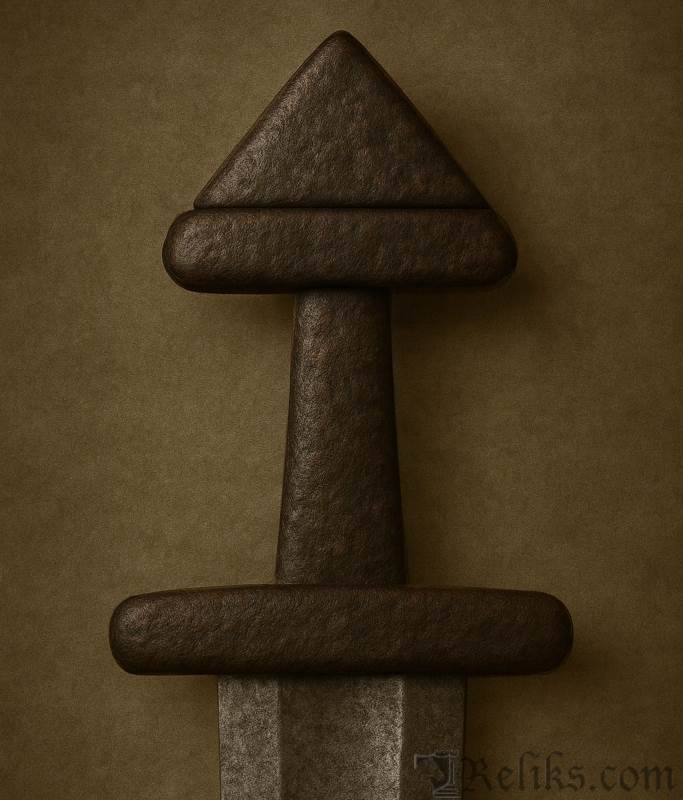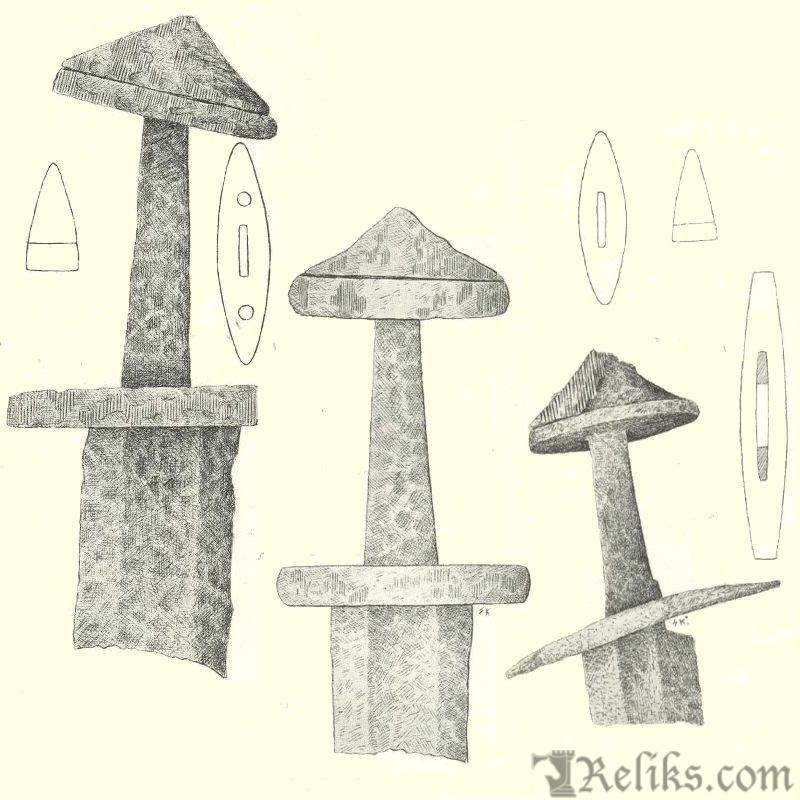Viking Sword Type I (c. 850–950+) – The Slender Successor to Type H
From Heavy to Slender
If Type H is the archetypal Viking sword, then Type I is its slimmer, younger sibling. Developed directly from H in the later 9th century, Type I carries the same three-part pommel and metal-inlaid decoration, but with a noticeably more elegant profile. It appears in fewer numbers (only 16 Norwegian examples are known), yet its distinct shape signals a clear stylistic shift in Viking weapon design.
Archaeological Description (Type I)

Viking Sword Type I
The swords of Type I present a sleeker, more refined profile compared to their predecessors. Both the upper and lower guards are noticeably slimmer and lower than those of Type H, with cross-sections shifting from the broad elliptical shape of earlier examples to a more pointed-oval form. The upper guard is narrower, typically measuring only about 1.8 to 2.3 centimeters across, compared to the 3.6 centimeters sometimes seen in H-types. Their height averages around a centimeter, giving the entire hilt a flatter, more streamlined appearance. The pommel retains the familiar three-lobed outline but takes on a sharper and taller form, with some examples displaying inward-curving lines that sweep gracefully from the top of the pommel down toward the guard ends. As with H-type swords, the pommel is generally fastened to the upper guard using small iron rivets.
Decoration follows the same strip-inlay technique so characteristic of the earlier type, employing silver, bronze, or occasionally brass to achieve contrasting patterns, sometimes producing a golden tone. One of the most remarkable examples is the sword from Kilde in Åmot (C 4094), which has a blade partially plated in brass or gold—a virtually unique survival. Another specimen from Opdal in Trøndelag (T 6293) features inlaid silver strips worked into branching motifs, while other pieces show simpler designs such as plain plates across the guard faces or, more rarely, guards constructed entirely of bronze. The blades themselves are predominantly double-edged, though at least one single-edged specimen is known. A few show traces of pattern-welding, but inscriptions do not appear to have been used on this type. Interestingly, Viking smiths sometimes blurred typological lines: one sword from Kjelstad, Nes (C 7101), bears an unusually long lower guard measuring 14.6 centimeters, a feature more reminiscent of the later Y-type. Such hybrids illustrate the fluidity of hilt-making traditions in the Viking Age, where workshops blended established forms with new experiments.
Distribution and Finds
Petersen documented 16 Norwegian finds:
- Concentrated in Eastern Norway (Akershus, Hedmark, Hadeland) and Trøndelag (especially Inntrøndelag).
- Rare in western Norway (none in the Bergen districts) and inland Buskerud.
- Outside Norway: found in Sweden (Birka, Närke, Södermanland, Östergötland), the Åland Islands, Russia, and a few Danish examples.
- A possible Irish specimen (Islandbridge) shows the same slender pommel profile, though attribution between H and I can blur.
Historical & Cultural Context

Petersen Sketches (fig.86-88)
Type I swords reflect a moment of regional refinement in eastern Scandinavia and Trøndelag, one in which Norse smiths built upon the legacy of the earlier H-type to produce more elegant, effective weapon forms. Their distribution suggests that these blades were not just imported icons, but locally adapted tools of power and warfare.
Technological refinements & metallurgy
The shift from H to I implies more than style—it hints at incremental technological advances in smithing and heat treatment. While full scientific consensus is elusive, metallurgical studies of Viking-age swords show trends toward simpler construction (fewer welded parts) and improved control over steel quality.
- Earlier Viking swords were often pattern-welded composites (interlaced strips of iron and steel) to balance hardness and flexibility. Over time, smiths increasingly used fewer components or even a single piece, reducing weak joints.
- The process of tempering (reheating quenched steel to reduce brittleness) was known and applied, enabling blades to better absorb shock without shattering.
“Ulfberht” swords—many contemporaneous with Type I—demonstrate extraordinary steel purity, consistent inlays, and strong construction, indicating that by the 9th–10th centuries, some bladesmiths had mastered more advanced techniques.
Thus, Type I may represent a “sweet spot” when aesthetic sophistication, metallurgical knowledge, and local needs aligned—smiths experimenting with cleaner forms, sharper edges, and more dependable blades.
Cultural & regional dynamics
In the 9th–10th centuries, eastern Norway and Trøndelag were in flux—politically, culturally, and economically. The Earls of Lade, based in Trøndelag, became key intermediaries in navigating Viking power, trade, and conflict.
Trade centers like Kaupang (Vestfold) would have linked coastal elites with wider networks of goods, including high-grade iron, bronze, and luxury imports. The proliferation of Type I swords in these zones speaks to elites who demanded high-status weapons that also functioned in real combat.
Life in that era was rife with warfare, raiding, and power struggles—but also governance, alliance-building, and settlement expansion. Swords were as much symbols as arms: heirlooms, status markers, and tools in the ritual politics of Vikings.
Weapon combinations & chronology
Type I swords don’t emerge in isolation. They are regularly found in graves alongside:
- Spearheads of the F and I types
- Axes of D, E, K, or L types
- Shield bosses such as R 562 or transitional forms
These companion artifacts help date the I-type to a period beginning in the later 9th century (c. 850+), overlapping late H variants, and continuing into the first half of the 10th century—some specimens perhaps reaching c. 950. Their company in graves, burials, and hoards associates them with a younger horizon of Viking martial equipment.
Closing Reflection
Where Type H embodied Viking solidity, Type I carried the design language into a leaner, later age. Likely born in eastern Scandinavia around the mid–late 9th century, it bridged the transition from the heavyset swords of early raiders to the sleeker profiles of the 10th century. Though fewer in number, Type I swords illustrate the Vikings’ ability to adapt, refine, and regionalize even within a shared tradition.
Seen in this light, Type I swords may represent more than a stylistic evolution. Their cleaner forms, more reliable construction, and continued prestige in burial contexts could reflect incremental metallurgical improvements, a growing demand for standardized weapons among elites, or simply a shift in fashion and symbolism within Viking warrior culture. Whether driven by technical advances in forging and tempering, by regional traditions in eastern Scandinavia and Trøndelag, or by social pressures to display wealth and authority, the I-type stands as a testament to how Norse swords remained both practical tools of war and cultural statements of power.
Core classification based on Jan Petersen, De Norske Vikingesverd (1919). Additional commentary by Reliks.com.